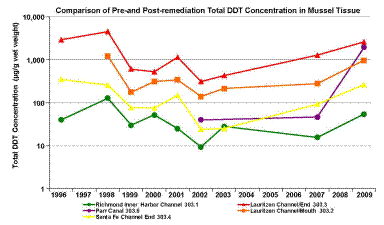| E-Mail Forum | |
|
|
|
| Do Not Eat Any Fish Caught Here - EPA to Brief City Council on United Heckathorn Fiasco at January 24 City Council Meeting January 21, 2012 |
|
|
On January 24, the Richmond City Council will receive a presentation from U.S. Environmental Protection Agency (EPA) representatives on the failed attempt 15 years ago to remove DDT residue from the Lauritzen Channel. (I-1. RECEIVE a presentation from the Environmental Protection Agency (EPA) on the status of cleanup of the United Heckathorn Superfund Site and provide direction to staff as appropriate - City Manager's Office (Bill Lindsay 620-6512).)
The site was supposedly cleaned in the mid-1990s, but a succession of three 5-year reviews all indicate the cleanup was a failure, yet the EPA has no firm plans to address the situation. For details, see:
Just a failure to address the DDT pollution levels that now exceed pre-cleanup contamination is bad enough, but it has now come to light that the same triumvirate of public agencies that has diverted environmental cleanup funds from Richmond for years successfully conspired in the 1990s to divert to Sonoma County funds secured from the Lauritzen Channel polluters instead of using these funds in Richmond. The following is from the Department Of The Interior, Fish and Wildlife Service, Notice of Availability, Restoration Plan and Environmental Assessment for Natural Resources Injured by Releases of Pesticides From the United Heckathorn Superfund Site: SUMMARY: The U.S. Fish and Wildlife Service, on behalf of the Department of the Interior, the National Oceanic and Atmospheric Administration, and the State of California, announces the release for public review of the Final Tubbs Island Restoration Plan and Environmental Assessment (Plan/Assessment) for a wetland restoration project at Lower Tubbs Island, Sonoma County, California. The Tubbs Island Restoration Project was selected by the United Heckathorn Natural Resource Trustee Council (Trustees), consisting of representatives of the agencies listed above, as the preferred alternative to compensate the public for impairment of fish and wildlife habitat resulting from releases of dichlorodiphenoltrichloroethane (DDT) at the United Heckathorn Superfund Site in Richmond, California. Funds to carry out the restoration program were obtained via Consent Decrees between the government and the responsible parties in July 1996, and the Final Tubbs Island Restoration Plan and Environmental Assessment was completed in August 1998, along with a Finding of No Significant Impact. Instead of compensating the people of Richmond or cleaning up the Lauritzen Channel, the U.S. Fish & Wildlife Service, the California Department of Fish and Game and the National Oceanic and Atmospheric Administration decided to erect the signs shown below and to move the compensation funds to Sonoma County. The remedy selected by EPA should provide overall protection of human health and the environment and should enable natural recovery of the benthic and water column communities in the dredged area. However, the degradation of the habitat during the decades between the pesticide releases and the cleanup resulted in a cumulative loss of ecological services in the Lauritzen Channel. These lost ecological services were estimated by the Natural Resource Trustees using Habitat Equivalency Analysis and formed the basis of settlements with the responsible parties for natural resource damages. The $365,000 settlement was based on estimates of the cost of restoration of habitat that would provide comparable services to fish, benthic invertebrates and fish-eating birds. This is was not the only time this diversion of funds occurred. Virtually every consent decree involving habitat damage in Richmond has resulted in funds being moved to Sonoma County. In each if the instances described below, federal and state officials claimed there was no project in Richmond that could use the funds.
This is a tragedy for the people of Richmond and an environmental justice outrage.
|
|
|
|

